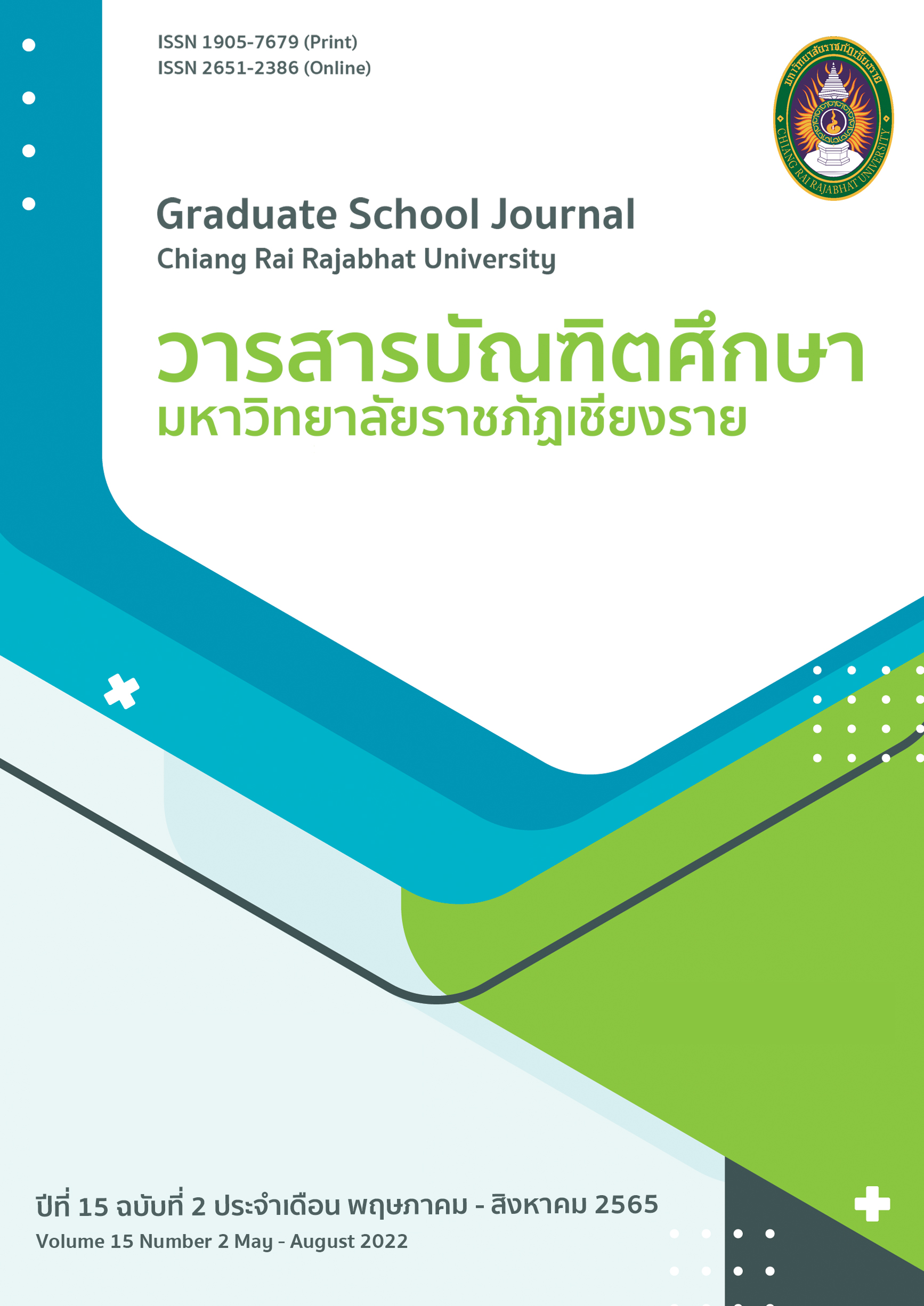ผลของการจัดกิจกรรมการเรียนรู้โดยวิธี IMPROVE ร่วมกับกระบวนการแก้ปัญหาของโพลยา ที่มีต่อความสามารถในการแก้ปัญหาและผลสัมฤทธิ์ทางการเรียนคณิตศาสตร์ เรื่อง หลักการนับเบื้องต้นของนักเรียนชั้นมัธยมศึกษาปีที่ 4 โรงเรียนกบินทร์วิทยา จังหวัดปราจีนบุรี
Main Article Content
บทคัดย่อ
การวิจัยนี้มีวัตถุประสงค์เพื่อเปรียบเทียบความสามารถในการแก้ปัญหาทางคณิตศาสตร์และผลสัมฤทธิ์ทางการเรียนคณิตศาสตร์ เรื่อง หลักการนับเบื้องต้น ของนักเรียนชั้นมัธยมศึกษาปีที่ 4
ที่ได้รับการจัดกิจกรรมการเรียนรู้โดยวิธี IMPROVE ร่วมกับกระบวนการแก้ปัญหาของโพลยา กลุ่มตัวอย่างเป็นนักเรียนชั้นมัธยมศึกษาปีที่ 4/1 จำนวน 43 คน โรงเรียนกบินทร์วิทยา ตำบลวังดาล อำเภอกบินทร์บุรี จังหวัดปราจีนบุรี ภาคเรียนที่ 2 ปีการศึกษา 2564 ซึ่งได้มาโดยการสุ่มแบบกลุ่ม เครื่องมือ
ที่ใช้ในการวิจัย ได้แก่ แผนการจัดกิจกรรมการเรียนรู้คณิตศาสตร์โดยวิธี IMPROVE ร่วมกับกระบวนการแก้ปัญหาของโพลยา แบบทดสอบวัดความสามารถในการแก้ปัญหาทางคณิตศาสตร์ และแบบทดสอบวัดผลสัมฤทธิ์ทางการเรียนคณิตศาสตร์ สถิติที่ใช้ในการวิเคราะห์ข้อมูล ได้แก่ ค่าเฉลี่ยเลขคณิต ส่วนเบี่ยงเบนมาตรฐาน และการทดสอบ t-test for one sample ผลการวิจัยพบว่า 1) ความสามารถในการแก้ปัญหาทางคณิตศาสตร์ของนักเรียนชั้นมัธยมศึกษาปีที่ 4 ได้รับการจัดกิจกรรมการเรียนรู้โดยวิธี
IMPROVE ร่วมกับกระบวนการแก้ปัญหาของโพลยา สูงกว่าเกณฑ์ร้อยละ 70 อย่างมีนัยสำคัญทางสถิติ
ที่ระดับ 0.05 2) ผลสัมฤทธิ์ทางการเรียนคณิตศาสตร์ของนักเรียนชั้นมัธยมศึกษาปีที่ 4 ได้รับการจัดกิจกรรมการเรียนรู้โดยวิธี IMPROVE ร่วมกับกระบวนการแก้ปัญหาของโพลยา สูงกว่าเกณฑ์ร้อยละ 70 อย่างมีนัยสำคัญทางสถิติที่ระดับ 0.05
Article Details

อนุญาตภายใต้เงื่อนไข Creative Commons Attribution-NonCommercial-NoDerivatives 4.0 International License.
บทความที่ได้รับการตีพิมพ์เป็นลิขสิทธิ์ของวารสารมหาวิทยาลัยราชภัฎเชียงราย
ข้อความที่ปรากฏในบทความแต่ละเรื่องในวารสารวิชาการเล่มนี้เป็นความคิดเห็นส่วนตัวของผู้เขียนแต่ละท่านไม่เกี่ยวข้องกับมหาวิทยาลัยราชภัฎเชียงราย และคณาจารย์ท่านอื่นๆในมหาวิทยาลัยฯ แต่อย่างใด ความรับผิดชอบองค์ประกอบทั้งหมดของบทความแต่ละเรื่องเป็นของผู้เขียนแต่ละท่าน หากมีความผิดพลาดใดๆ ผู้เขียนแต่ละท่านจะรับผิดชอบบทความของตนเองแต่ผู้เดียว
เอกสารอ้างอิง
กระทรวงศึกษาธิการ. (2560). ตัวชี้วัดและสาระการเรียนรู้แกนกลาง กลุ่มสาระการเรียนรู้คณิตศาสตร์ (ฉบับปรับปรุง พ.ศ.๒๕๖๐) ตามหลักสูตรแกนกลางการศึกษาขั้นพื้นฐาน พุทธศักราช ๒๕๕๑. กรุงเทพมหานคร: กระทรวงฯ.
จุลจิรา ปิ่นมั่น. (2557). ผลการสังเคราะห์รูปแบบกิจกรรมการเรียนรู้แบบสืบเสาะหาความรู้ 5Es ร่วมกับกระบวนการแก้ปัญหาของโพลยา เรื่อง การประยุกต์ของสมการเชิงเส้นตัวแปรเดียวของนักเรียนชั้นมัธยมศึกษาปีที่ 5. (วิทยานิพนธ์ศึกษามหาบัณฑิต). มหาวิทยาลัยบูรพา. ชลบุรี.
ธัญญารัตน์ อินทร์อนันต์. ครูโรงเรียนกบินทร์วิทยา จังหวัดปราจีนบุรี. สัมภาษณ์. 10 มิถุนายน 2564.
พิมพ์ลดา สินธุวานา. (2558). ผลการจัดการเรียนแบบร่วมมือเทคนิคการแบ่งกลุ่มผลสัมฤทธิ์ร่วมกับกระบวนการแก้ปัญหาของโพลยา ที่มีต่อความสามารถในการแก้ปัญหาทางคณิตศาสตร์ของนักเรียนชั้นประถมศึกษาปีที่ 5. (วิทยานิพนธ์ศึกษามหาบัณฑิต). มหาวิทยาลัยบูรพา. ชลบุรี.
วรรณิภา เรียบเรียง. (2561). การศึกษาความสามารถในการแก้ปัญหาและการให้เหตุผลทางคณิตศาสตร์ เรื่อง ความน่าจะเป็น ของนักเรียนชั้นมัธยมศึกษาปีที่ 3 โดยใช้การจัดการเรียนรู้ตามวิธี IMPROVE. (วิทยานิพนธ์วิทยาศาสตรมหาบัณฑิต). มหาวิทยาลัยราชภัฏนครราชสีมา. นครราชสีมา.
ศศิธร โมลา. (2560). ความสามารถในการแก้ปัญหาทางคณิตศาสตร์ ผลสัมฤทธิ์ทางการเรียนและเจตคติต่อวิชาคณิตศาสตร์ นักเรียนชั้นมัธยมศึกษาปีที่ 1 ที่เรียนโดยรูปแบบสืบเสาะหาความรู้ 5Es ร่วมกับกระบวนการแก้ปัญหาของโพลยา. (วิทยานิพนธ์ศึกษามหาบัณฑิต). มหาวิทยาลัยบูรพา. ชลบุรี.
ศักดิ์ศรี ปาณะกุล, นิรมล ศตวุฒิ และ ระวิวรรณ ศรีคร้ามครัน. (2556). หลักสูตรและการจัดการเรียนรู้. กรุงเทพมหานคร: สำนักพิมพ์มหาวิทยาลัยรามคำแหง.
สถาบันทดสอบทางการศึกษาแห่งชาติ. (2562). รายงานผลการทดสอบทางการศึกษาระดับชาติขั้นพื้นฐาน (O-NET) ช่วงชั้นที่ 3 (มัธยมศึกษาปีที่ 6). สืบค้นจาก http://www.newonetresult.niets.or.th/AnnouncementWeb/Login.aspx.
สถาบันส่งเสริมการสอนวิทยาศาสตร์และเทคโนโลยี. (2555). การวัดผลประเมินผลคณิตศาสตร์. กรุงเทพมหานคร: สถาบันฯ.
สถาบันส่งเสริมการสอนวิทยาศาสตร์และเทคโนโลยี. (2562). การแก้ปัญหาแบบร่วมมือ (Collaborative Problem Solving) บทสรุปสำหรับผู้บริหาร. กรุงเทพมหานคร: สถาบันฯ.
สุทธดา เหลืองห่อ. ครูโรงเรียนกบินทร์วิทยา จังหวัดปราจีนบุรี. สัมภาษณ์, 10 มิถุนายน 2564.
อรนุช ลิมตศิริ. (2556). หลักสูตรและการเรียนการสอนในระดับประถมศึกษา (พิมพ์ครั้งที่ 6). กรุงเทพมหานคร: สำนักพิมพ์มหาวิทยาลัยรามคำแหง.
Chiappetta, E. L., & Russell, J. M. (1982). The relationship among logical thinking, problem Solving instruction and knowledge and application of earth science subject matter. Science Education, 66(1), 85-93.
Klausmeier, H. J. & Ripple, R. E. (1971). Learning and human abilities : Educational psychology. New York: Harper and Row.
Mevarech, Z. R. & Kramarski, B. (1997). IMPROVE : A multidimensional method for teaching mathematics in heterogeneous classrooms. American Educational Research Journal Summer, 34(2), 365-394.
Polya, G. (1957). How to solve it: A new aspect of mathematic method. New York: Doubleday & Company.
Polya, G. (1985). How to solve it. New Jersry: Princeton University Press.
Schoenfeld, A. H. (1985). Making sense of “Out Loud” problem solving protocols. The Journal of Mathematical Behavior, 4, 171-191.


